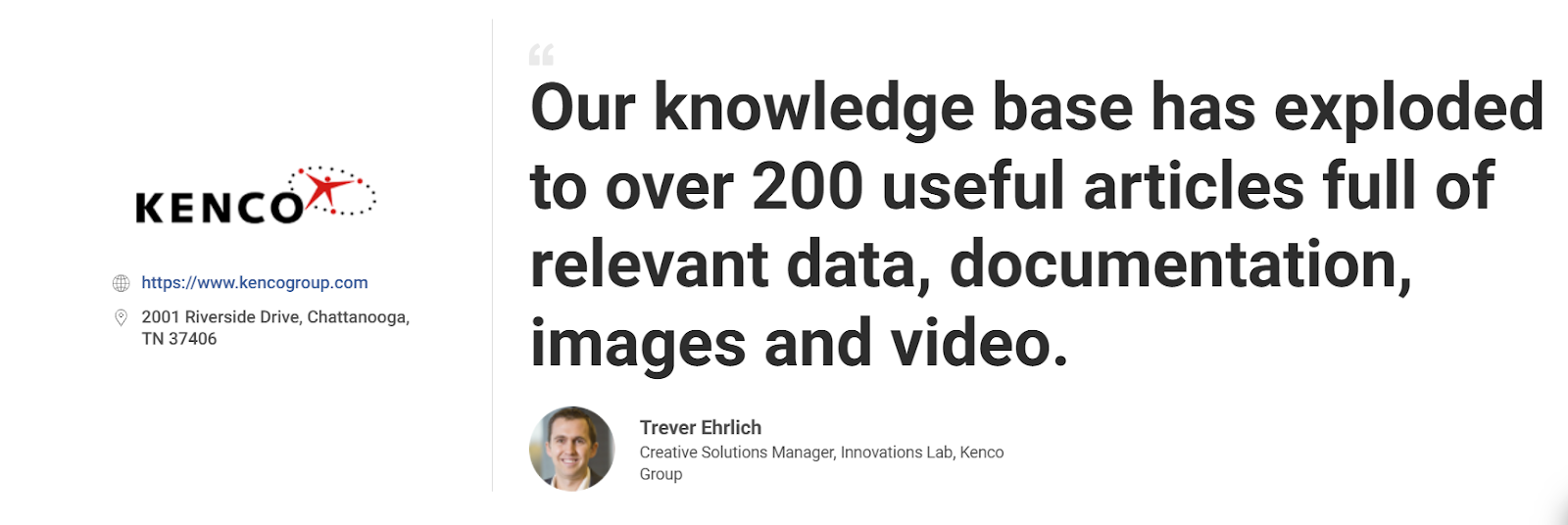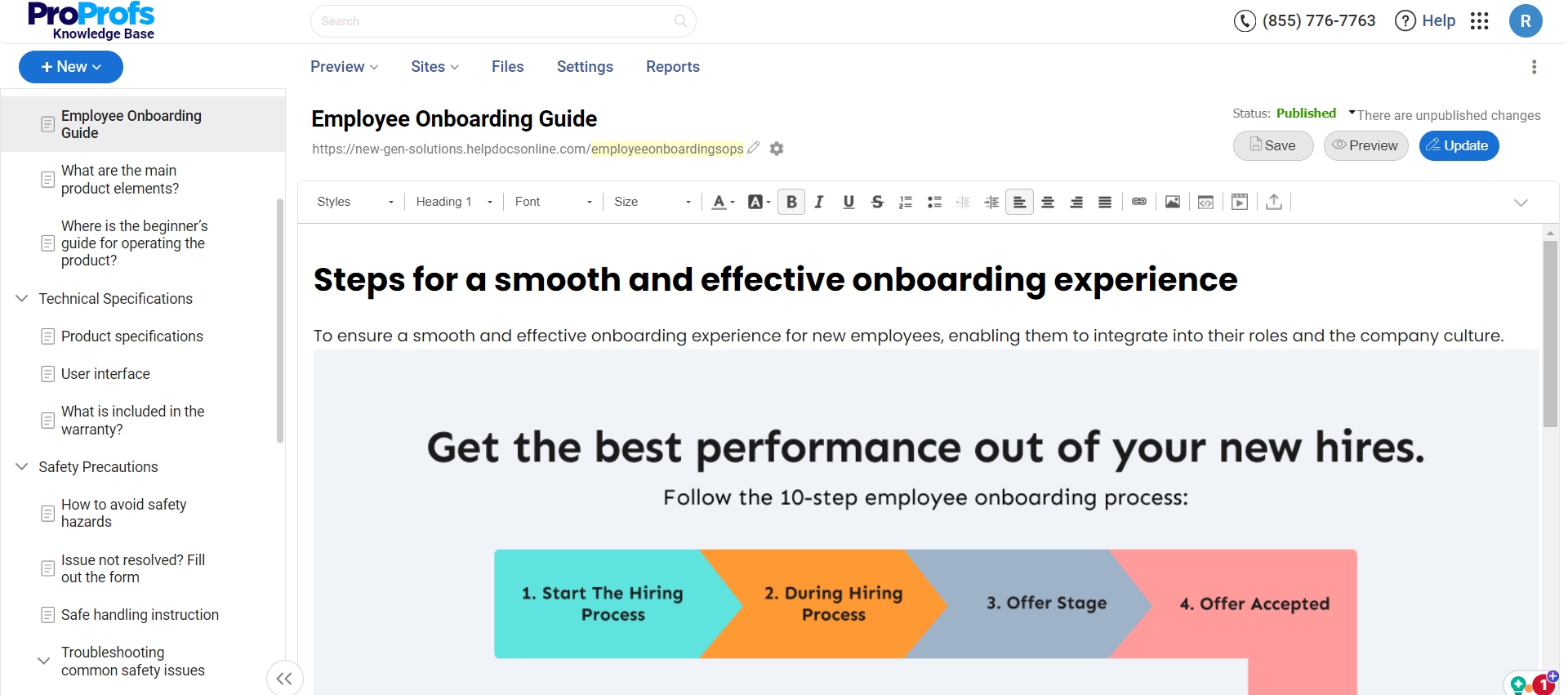I’ve seen what happens when a team tries to grow without an SOP manual: it’s like playing telephone with your business processes. Everyone’s doing their own version of the same task, no one’s sure which version is right, and chaos hides in plain sight.
If your SOPs (standard operating procedures) live in someone’s head or a forgotten drive folder, you don’t have standards; you have educated guesswork.
Over the last decade, I’ve helped teams, from overworked HR departments to fast-scaling support teams, turn messy processes into clean, repeatable systems. And the secret isn’t more meetings or more tools. It’s a simple, well-structured SOP manual that speaks for you when you’re not in the room.
This guide will explain what an SOP manual is, why your team needs one, and exactly how to create one without losing your mind (or your weekends).
What Is an SOP Manual?
A standard operating procedures manual is a centralized document that outlines standardized procedures for carrying out routine tasks within an organization. It provides step-by-step instructions, assigns responsibilities, and ensures consistency across teams and processes.
By following an SOP manual, employees know exactly what to do, when to do it, and how to do it, reducing confusion, saving time, and minimizing operational errors. This is especially useful for training new hires and maintaining quality across departments.
For example, a customer support team might have an SOP manual that details how to handle refund requests, from verifying the order to processing the refund and sending a confirmation email, ensuring every agent follows the same steps every time.
Let me show you a real-life example of how Kenco created 200+ articles, including manuals, using a user manual software platform.

What Are the Purpose & Benefits of Creating SOP Manuals?
An SOP manual isn’t just a set of instructions; it’s a strategic asset that brings clarity, consistency, and accountability to every corner of your organization.
Whether you’re onboarding new hires or ensuring regulatory compliance, a well-structured SOP manual sets the foundation for operational excellence.
1. Standardization
SOP manuals ensure that every task is carried out the same way, every time, regardless of who performs it. This eliminates guesswork, reduces variability, and helps maintain quality across departments and teams.
2. Training & Onboarding
New employees can ramp up faster when they have access to step-by-step procedures for their roles. Instead of relying on verbal guidance or shadowing, they get a self-serve resource to learn, practice, and perform confidently.
3. Scalability
As your team grows or expands across locations, an SOP manual allows you to replicate your best processes without reinventing the wheel. It acts as an operational blueprint that can scale with your business.
4. Compliance & Risk Management
Industries like healthcare, finance, and manufacturing rely on documented SOPs to meet regulatory standards. A centralized manual helps you demonstrate compliance during audits and reduce legal or operational risks.
5. Performance Tracking
By linking SOPs with performance metrics, you can track how well procedures are followed and where gaps exist. This enables continuous improvement and ensures your documentation evolves with changing needs.

Best Practices: Before, During & After Creating an SOP Manual
Creating effective SOP user manuals requires clear structure, user-focused content, and continuous improvement.
1. Before Creating SOP User Manuals
- Identify your target audience and their skill levels, roles, and specific needs
- Analyze existing SOPs to determine gaps, outdated procedures, and improvement areas
- Define the scope and objectives for each manual, including compliance requirements
- Gather input from process owners, end users, and subject matter experts
- Choose an appropriate format and delivery method (digital, print, or hybrid).
2. During the SOP Manual Creation Process
- Structure content with clear headings, numbered steps, and logical flow
- Use simple, direct language and avoid jargon or technical terms when possible
- Include visual elements like flowcharts, diagrams, and screenshots for clarity
- Add safety warnings, cautions, and critical decision points prominently
- Test procedures by having someone unfamiliar with the process follow your manual.
3. After SOP Manual Creation
- Conduct user testing with actual end users and gather detailed feedback
- Implement a version control system and establish approval workflows
- Provide training sessions and ensure manuals are easily accessible to all users
- Set up regular review cycles to keep procedures current and compliant
- Monitor usage patterns and update based on user questions and process changes.
How to Create an SOP Manual: Step-by-Step Guide
Creating accurate and easy-to-follow SOP manuals doesn’t have to be overwhelming, especially when you’re backed by a robust knowledge base platform that simplifies the entire process.
For instance, we use ProProfs Knowledge Base to build SOP manuals for everything from employee onboarding to customer support workflows. Here’s how you can do the same, step by step:
1. Choose a Template or Build from Scratch

Start by setting up a dedicated site for your SOP manual. You can either select a ready-to-use SOP or an internal manual template, or build your structure from scratch.
Follow these steps:
- After logging into your knowledge base, go to Sites > +Create New
- Pick your preferred layout, and organize content into folders such as “HR SOPs,” “IT Operations,” or “Finance Procedures.”
This sets the foundation for consistency across your organization’s documentation.
2. Customize the Manual to Match Your Processes

Once your site is ready, personalize it to reflect your internal language and process types. Here’s how:
- Use Edit Home to adjust the layout, navigation, fonts, and color scheme
- Add your organization’s branding and rename sections based on teams or departments.
This will help users quickly find SOPs relevant to their role.
3. Import Existing SOPs or Drafts for a Head Start

Already have SOPs buried in PDFs, Word docs, or spreadsheets? Import them directly by navigating to import your existing content.
Here’s how:
- Click Settings in the header menu, and from the dropdown, select the site to import files
- Go to Import Sites > Import Files.
This lets you bulk-upload existing materials into draft mode for formatting and review, saving hours of manual copy-paste work.
4. Draft or Improve SOPs Using the AI Writer

Whether you’re starting from scratch or improving imported docs, the AI Writer can help you quickly create clear and complete SOPs.
Here’s how:
- Click +New, choose Page, and select Article as the template
- Click on the AI icon, select Generate with AI, and let it help generate content for specific tasks.
You can use a prompt like this by modifying it according to your desired result:
“Generate a brief SOP manual to explain [how customer support agents should handle refund requests]. It must be written in simple language, include clearly labeled sections, follows a step-by-step format, and be optimized for web readability.
Use headings and numbered steps, and include an FAQ section at the end with two common questions. Make it friendly but professional.”
Here’s what the result would look like:


5. Structure SOPs for Clarity & Actionability

Each SOP should be broken down into clean, easy-to-follow steps. Start with the objective, define who owns the process, and list the required tools or inputs.
Then, use numbered instructions, decision points, and role-based tags to make each task crystal clear. Here’s how:
Follow these steps to add a Merge Tag:
- Choose the location where you want to add dynamic content, such as links to related articles or categories.
- Click on the Merge Tags icon in the toolbar and choose the tag you need (e.g., article links, categories, or related content).
- Insert the tag into the article, and it will automatically pull the relevant content.
Now, to add a ToC:
- In the Article Settings, enable the Table of Contents
- The system automatically scans your article for headings and subheadings, creating a TOC with clickable links.
6. Add Multimedia, Links & Cross-References

Enhance your SOPs with screenshots, videos, diagrams, or flowcharts to make procedures easier to understand.
Use the WYSIWYG editor to embed media or drag and drop files directly into your article.
Method #1
- Select the image(s) from the file location
- Drag the selected images and drop them in your browser’s ProProfs Knowledge Base editor tab.
Method #2
- Right-click on the image and select copy or use CTRL+C
- Right-click in the Knowledge Base editor or press CTRL+V to paste the image.
7. Assign SOP Owners & Add Review Cycles

Assign each SOP a responsible owner, someone who understands the workflow and can keep it updated.
Use role-based access controls to give editors and contributors permission to revise only what they own. Here’s how to do it:
- Use role-based access controls to define what content each team can view, edit, or manage.
- To control permissions at different levels, create different roles, such as “Admin,” “Editor,” and “Viewer.”
- You can assign team members to specific content, ensuring they only see what’s relevant to their department.

- In the article Status, select Ready for Review to notify the administrator of this status change
Once they review and edit it, they can simply change the Status to Published.
8. Preview, Publish & Keep SOPs Current

Before publishing, preview it to check formatting, verify links, and make sure each SOP is easy to follow.
Once finalized, hit publish. Here’s how:
- Click the Edit icon on the home page and use the Preview function to see how it will look to your audience
- Click Save & Done, and your documentation will automatically publish
You can also share the manual URL, export it as a PDF, extract page details in JSON/XML/CSV, or create a backup in HTML.
FREE. All Features. FOREVER!
Try our Forever FREE account with all premium features!
What Are the Components of an SOP Manual?
A well-structured SOP manual consists of several essential components that provide employees with a thorough and organized resource. These components include:
1. Title & Table of Contents
An SOP manual starts with a clear and descriptive title and a table of contents. The table of contents gives an overview of the manual’s sections, making it easier for users to navigate and locate specific procedures.
2. Introduction
The manual’s introduction sets its context and purpose. It explains the significance of following standard procedures, outlines the benefits of consistency, and highlights the organization’s overall goals.
3. Scope & Objectives
This section details the scope of the SOP manual, specifying the tasks and processes covered.
It outlines the manual’s objectives and explains what it aims to achieve and how it aligns with the organization’s goals.
4. Roles & Responsibilities
The roles and responsibilities section details the key positions involved in each task or process.
It also explains the responsibilities of individuals or teams, ensuring that everyone understands their roles and who to consult for assistance or approval.
5. Procedures
The procedures section is the core of the SOP manual. It provides step-by-step instructions, usually in chronological order, for performing specific tasks or processes.
Each instruction is written clearly and concisely, using simple language that employees easily understand. It could also include visual aids like diagrams or photographs to enhance comprehension.
6. Forms & Templates
This section includes any relevant forms or templates that employees may need to complete during the execution of procedures.
These consist of checklists, log sheets, inspection forms, or incident reports. Providing these resources ensures consistency and compliance with documentation requirements.
7. References & Appendices
The references section consists of any external documents or references necessary for performing the procedures correctly.
This may include industry standards, regulations, safety guidelines, or other relevant documentation. Appendices can be added to provide additional details, explanations, or supporting materials that may be helpful to users.
8. Revision History & Approval
It is an essential element of an SOP manual, as it helps to track changes made to it.
It documents the dates of revisions, who made the changes, and the approval process, ensuring that the manual is always up-to-date and authorized by the appropriate personnel.
How to Measure the Success of Your SOP Manual: Metrics & Tools
Measuring the success of your SOP manual is just as important as creating it. Without tracking performance, you won’t know if your documentation is being used or making an impact.
1. Track Metrics That Matter
- Training time reduction: Monitor how quickly new hires ramp up compared to before the SOP manual was introduced.
- Task completion time: Track how long it takes employees to complete recurring tasks with and without SOP guidance.
- Number of errors/quality issues: Evaluate whether SOP-driven processes are reducing mistakes, rework, or compliance gaps.
- Employee feedback: Collect insights from users on clarity, usefulness, and missing steps to identify areas for improvement.
2. Use Analytics Tools to Assess Usage & Gaps
Leverage built-in knowledge base analytics to see which SOPs are being viewed, which ones are ignored, and where users are dropping off.
Look for trends in search queries and use that data to fill content gaps, restructure confusing procedures, or update outdated instructions.
Examples of SOP Manuals
Exploring SOP manual examples provides valuable insights into best practices, legal compliance, and efficient workflows, helping you understand how companies approach it:
1. HR SOP Manual

You can use a knowledge base platform to create HR SOPs with its AI-powered WYSIWYG editor and built-in prompts.
Such platforms also make it easy to create an engaging experience by allowing for a Table of Contents, encouraging simple language, and supporting the seamless inclusion of rich multimedia like dashboard screenshots, charts, and GIFs.
You can use this format for creating an HR SOP:
1. Scope & Purpose
- Scope: This SOP governs the initial candidate screening process for all open positions and applies to members of the Human Resources and hiring teams responsible for reviewing applications.
- Purpose: The purpose of this SOP is to ensure a consistent, efficient, and unbiased review of every job application. By following these steps, we can fairly evaluate candidates against a clear set of qualifications and identify a qualified talent pool to advance to the interview stage.
2. Process Steps
- Application Intake & Review: Access the Applicant Tracking System (ATS) to view all submitted applications. Begin the screening process within 24-48 hours of receiving an application to ensure a timely response to candidates.
- Evaluate Against Minimum Qualifications: Compare each candidate’s resume and cover letter against the minimum qualifications and required skills listed in the job description. At this stage, candidates who do not meet these non-negotiable requirements should be declined.
- Conduct a Standardized Evaluation: For all candidates who meet the minimum qualifications, use a pre-defined scoring matrix to objectively rank their resumes. The matrix should be based on a point system for specific skills, years of experience, and relevant accomplishments to minimize unconscious bias.
- Create a Shortlist: Select the top-scoring candidates from the standardized evaluation to form the shortlist. The hiring manager will recommend this group for the next stage of the interview process.
- Document and Communicate: Log all evaluation scores and screening decisions in the ATS for compliance and future reference. All candidates who are not moving forward must be sent a standardized, professional rejection email.
3. Reference Documents & Tools
- Official Job Description: The official document outlining the role’s responsibilities, required qualifications, and desired skills.
- Standardized Scoring Matrix: A document or tool used to objectively rank candidates based on defined criteria.
- Applicant Tracking System (ATS): The primary system for managing applications, logging decisions, and communicating with candidates.
- Company Interviewing Policy: Guidelines and procedures for conducting fair and legal interviews.
- Offer Letter Templates: Sample documents used for extending an offer of employment.
2. Manufacturing Equipment Calibration SOP Manual
Document Number: SOP-EC-001
Effective Date: August 1, 2025
1. Purpose
To ensure equipment accuracy and compliance through regular calibration.
2. Scope
Applies to all equipment requiring calibration in the facilities.
3. Responsibilities
- Calibration Technician: Performs and documents calibration.
- Quality Assurance (QA) Manager: Oversees calibration activities and compliance.
- Maintenance Supervisor: Coordinates scheduling and execution of calibration.
4. Procedure
Schedule:
Follow a calibration schedule based on equipment type and manufacturer recommendations.
Standards:
Use certified, traceable calibration standards.
Perform Calibration:
Calibrate equipment according to the manufacturer’s instructions.
Document results, including any adjustments made.
Documentation:
Complete Calibration Record forms and file in Equipment Calibration Log.
Corrective Actions:
Address and document any deviations or equipment failures.
Training:
Ensure personnel are trained in calibration procedures.
Bring Clarity & Consistency to Your Processes With SOP Manuals
SOP manuals aren’t just documents; they’re powerful tools that drive clarity, speed, and consistency across teams. They help reduce errors, streamline training, and scale processes with confidence.
Start small by documenting 1–2 critical workflows, then expand as your team grows.
With ProProfs Knowledge Base, you can create structured, searchable SOPs using templates, role-based access, and built-in AI writing tools that help you draft and refine content faster. It’s everything you need to build a high-impact SOP manual, without the overwhelm.
 Tips
Tips
We’d love to hear your tips & suggestions on this article!
FREE. All Features. FOREVER!
Try our Forever FREE account with all premium features!







